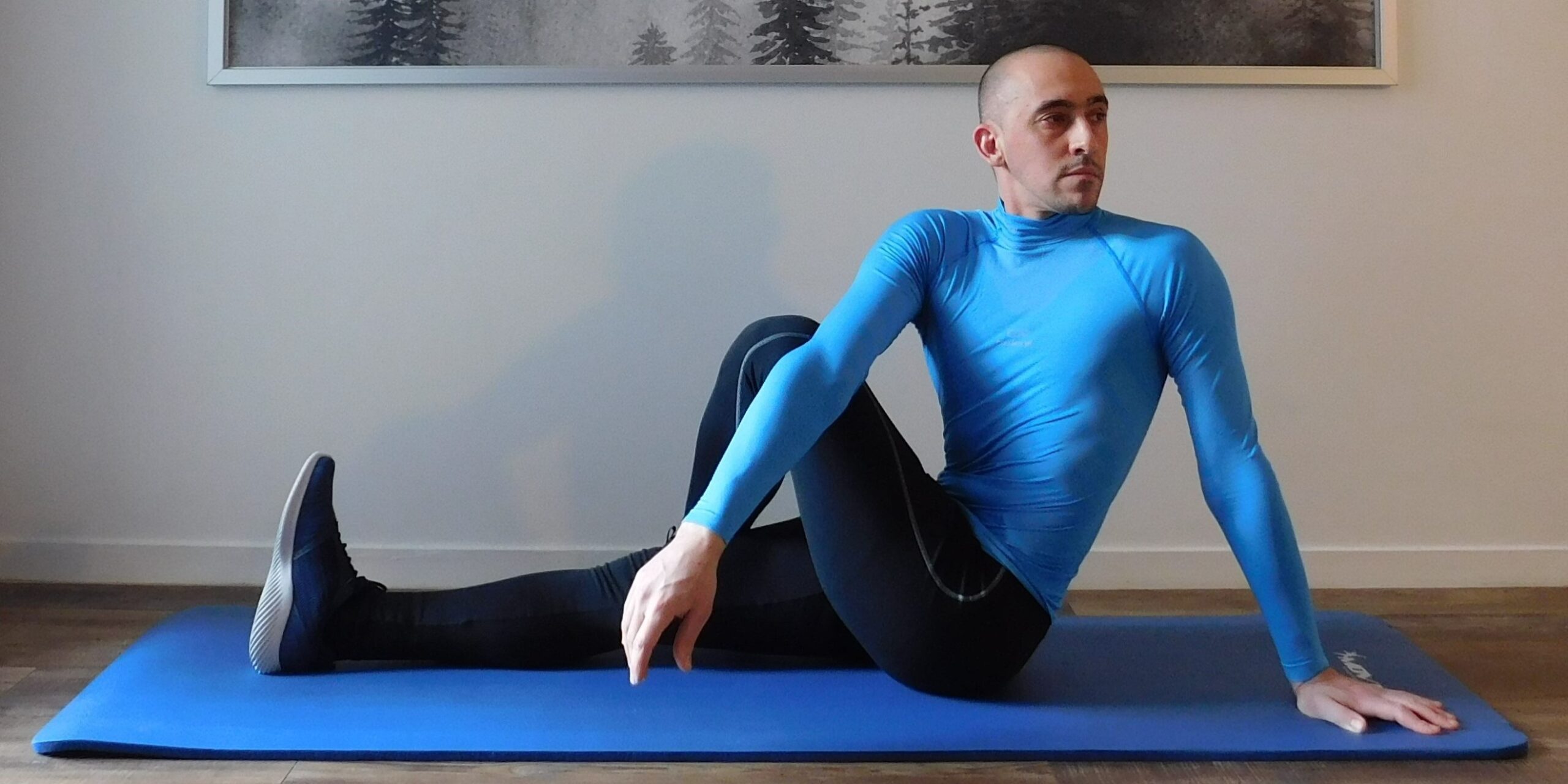21 stretching exercises for better flexibility
Stretching plays an important role in Chinese massage Tuina, just like the mobilizations. Indeed, the work of the flexibility is essential whether as part of your daily life or in a well-balanced sports program. Incorporating stretching exercises can help you improve your flexibility, reduce tension and ultimately make your life more enjoyable, and your workouts more effective and safer.
Tight muscles can exert a excessive pressure on joints neighbors during normal daily activities, or they may injure themselves. As we age, our muscles become shorter and less elastic. We must take an active role in maintaining and improving the length of our muscles so that we can continue to benefit from our abilities painless.
Generally, stretching is neglected. However, although they are perceived as uncomfortable and require time, they are essential for taking care of your body in the long term while avoiding the risk of pain and injury. When doing physical activities that will contract the muscles (which will induce a shortening of the muscle fibers), it is necessary to stretch regularly (to lengthen the muscle fibers). Only in this way will you succeed in maintaining your muscular balance. Without stretching, the imbalances in the body increase the risk of injury because they can cause certain muscles and joints to overcompensate for others that are too tight to engage properly. This causes tension and some discomfort.
This is where stretching comes in, whether it'sback, upper body or leg stretches. No matter where your muscles are tight, stretching and flexibility exercises can help.huge relief. Read on to learn why stretching is so important, then try some of the 21 stretching exercises below!
For stretches which will mainly aim to relieve your back pain localized to the lower back, I invite you to consult the article Relieve lumbago with yoga.
For those who suffer from knee pain, I invite you to consult the article How to relieve knee pain? for specific stretches.
Summary
Here are the stretches that I suggest to you
- Standing Hamstring Stretch
- Stretching the piriformis muscle
- Lunge with spinal rotation
- Triceps stretch
- Hip stretch
- Hip Stretch: Pigeon Pose
- Frog Stretch
- Butterfly stretch
- Seated Shoulder Stretch
- Lateral Bend Stretch
- Lunge Hip Flexor Stretch
- Lying pectoral stretch
- Knee to Chest Stretch
- Seated Neck Stretch
- Lying Quadriceps Stretch
- Sphinx pose
- Lying puppy pose
- Pretzel pose
- Adductor stretch
- Standing Quadriceps Stretch
- Knees to chest
Why is stretching so important?
The benefits of stretching are numerous. First, stretching increase flexibility, which can improve your range of motion in the short and long term. This is important, because better range of motion can mean better muscle recruitment during your physical activities. For example, a greater range of motion in your hips and knees will make it easier for you to lower yourself to lift your child without hurting your back. Ultimately, a better range of motion will allow you to do more things correctly.
We can use the word 'mobility' rather than 'flexibility' to emphasize the importance of stretching in daily life. The older we get, the more difficult everyday things like bending down to tie a shoe, climbing stairs, or even just getting up from the couch become. Improving your mobility makes these daily activities easier. You can thus move more freely.
Stretching can also relieve pain, which can result from muscle contraction during workouts or when we sit hunched over our desk for hours. They can also alert to muscle imbalances, for example if one side is tighter than the other when you do one of your favorite hip stretches.
When should you stretch?
The type of stretch matters when talking about the best time to stretch. THE dynamic stretching, which involve movement, prepare your body for a workout. These pre-workout stretches are movement oriented. On the other hand, the static stretching, which involves maintaining a given position, helps your body settle after a workout. This will help speed up the recovery process. Ending your workout with static stretches can help your mind relax and signal the end of your workout. We'll focus on static stretching in the movements below.
Fortunately, improve your flexibility and mobility is not difficult. It just takes a little time. Try adding the flexibility stretches shown and explained below – lower back and upper back stretches to hamstring and quadriceps stretches, going through movements that soften the shoulders – to your routine to relieve muscle tension and increase mobility throughout your body.
Noticed : If you suffer from joint pain or discomfort, or are looking for specific stretching exercises to relieve pain, you may want to consult your physical therapist before beginning a stretching program. He will be able to tell you the specific movements best suited to your needs.
How to stretch correctly?
Below you will find a series of stretching exercises that will allow you to relax your entire body. Some exercises correspond to yoga postures. The way you stretch is important and I advise you to warm up for 5 to 10 minutes at the start of your session. You have to remember to breathe throughout the stretch. During the hold, you should feel a slight tension which tells you that the muscle is working, but you should not feel any pain. If you are not flexible, there is no need to look for a lot of amplitude from the start. You will gain flexibility little by little, over the weeks.
Here are the stretches that I recommend
Below, Simo Benadada demonstrates the movements to you.
1
Standing Hamstring Stretch
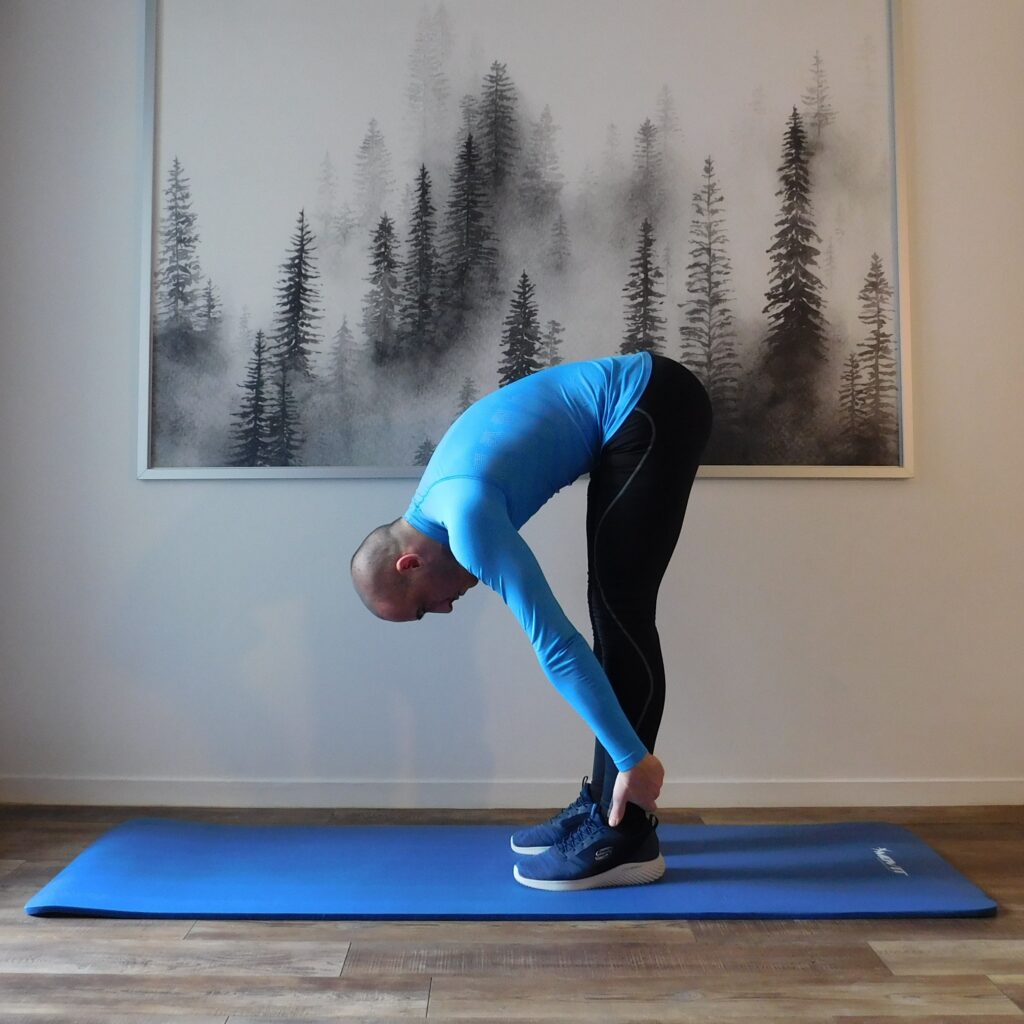
- Stand with your feet hip-width apart, knees slightly bent, and arms at your sides.
- Exhale as you bend forward at the hips, lowering your head toward the floor while keeping your head, neck, and shoulders relaxed.
- Wrap your arms around the backs of your legs and hold this position for between 45 seconds and 2 minutes.
- Bend your knees and roll back up when finished.
Neck, back, glutes, hamstrings and calf stretches.
2
Stretching the piriformis muscle
The piriformis muscle is a deep muscle of the buttock. It is the external rotator of the hip and has the role of stabilizing it. As the piriformis crosses the sciatic nerve, if it is tight it can lead to irritation of the sciatic nerve (piriformis syndrome). In this case, there is pain in the buttock which can radiate down the back of the thigh to the knee. Stretching this muscle can prevent or help treat potential future sciatica.
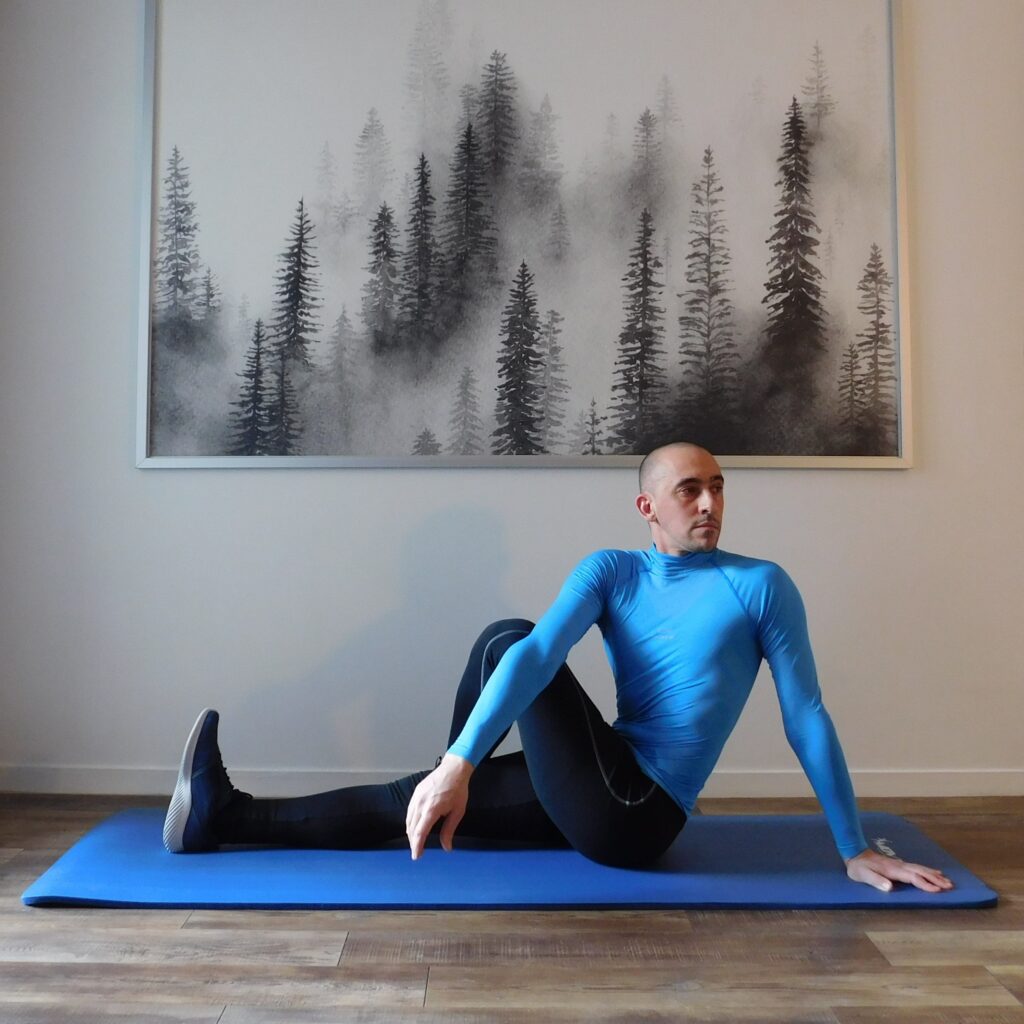
- Sit on the floor with both legs extended in front of you.
- Cross your left leg over your right leg, and place your left foot flat on the floor.
- Place your left hand on the floor, behind your body.
- Place your right hand on your left quad or your right elbow on your left knee (as shown in the photo) and push your left leg to the right while rotating your torso to the left.
- If spinal rotation is bothering your back, remove it and simply use your right hand to pull your right quadriceps inward.
- Hold this position for 30 seconds, repeat the exercise on the other side then alternate a second time.
Hip, back and glute stretches.
3
Lunge with spinal rotation
This stretch is essential for relieving pain related to posture or for people who sit for long periods of time. It allows you to open the hips and improve thoracic mobility, particularly in the middle and lower back.
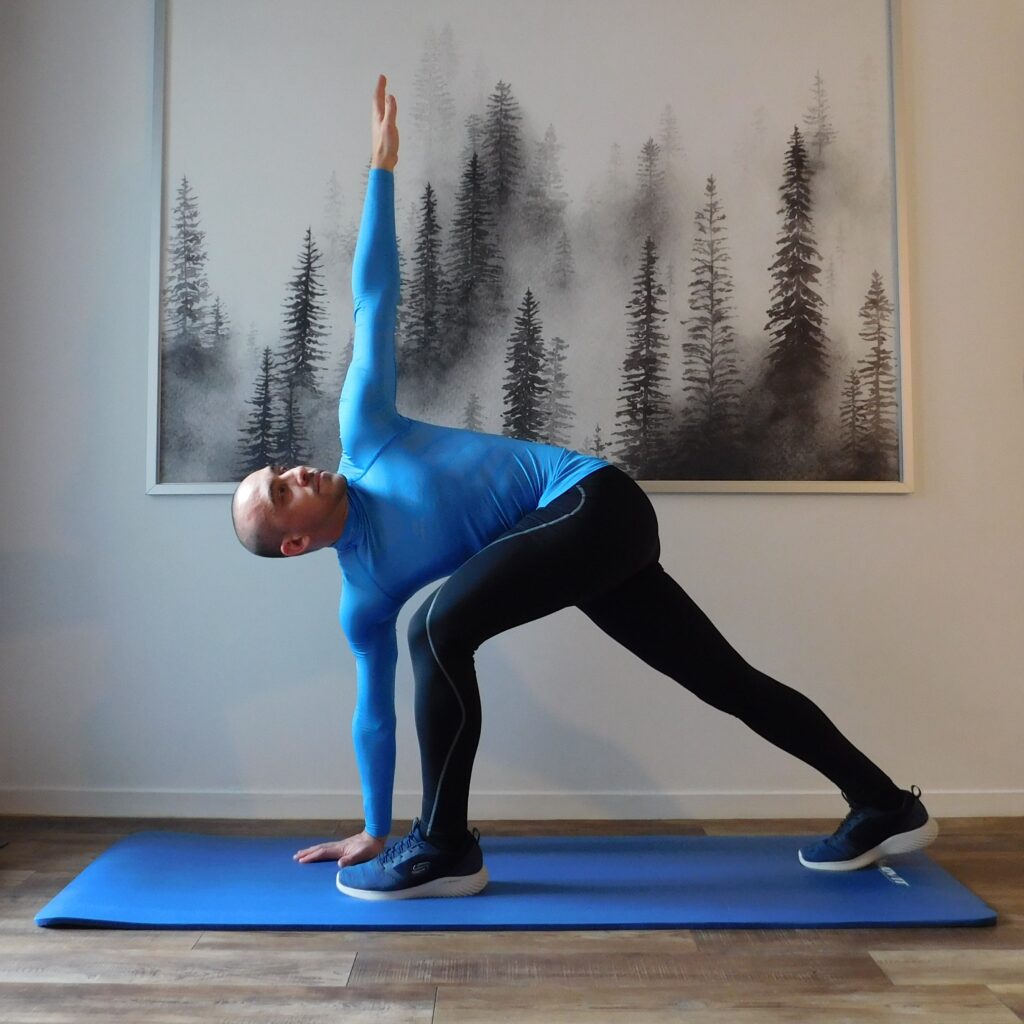
- Start by standing with your feet together.
- Take a big step forward with your left foot, so that you find yourself in a staggered position.
- Bend your left knee and lunge, keeping your right leg straight behind you, toes on the floor, so you feel a stretch in the front of your right thigh.
- Place your right hand on the floor and rotate your upper body to the left, stretching your left arm toward the ceiling.
- Hold this position for 30 seconds to 2 minutes.
- Repeat the exercise on the other side.
Hip flexor, quadriceps and back stretches.
4
Triceps stretch
The triceps stretch, one of the most popular upper body stretches, relaxes the muscles in the back of your arms.
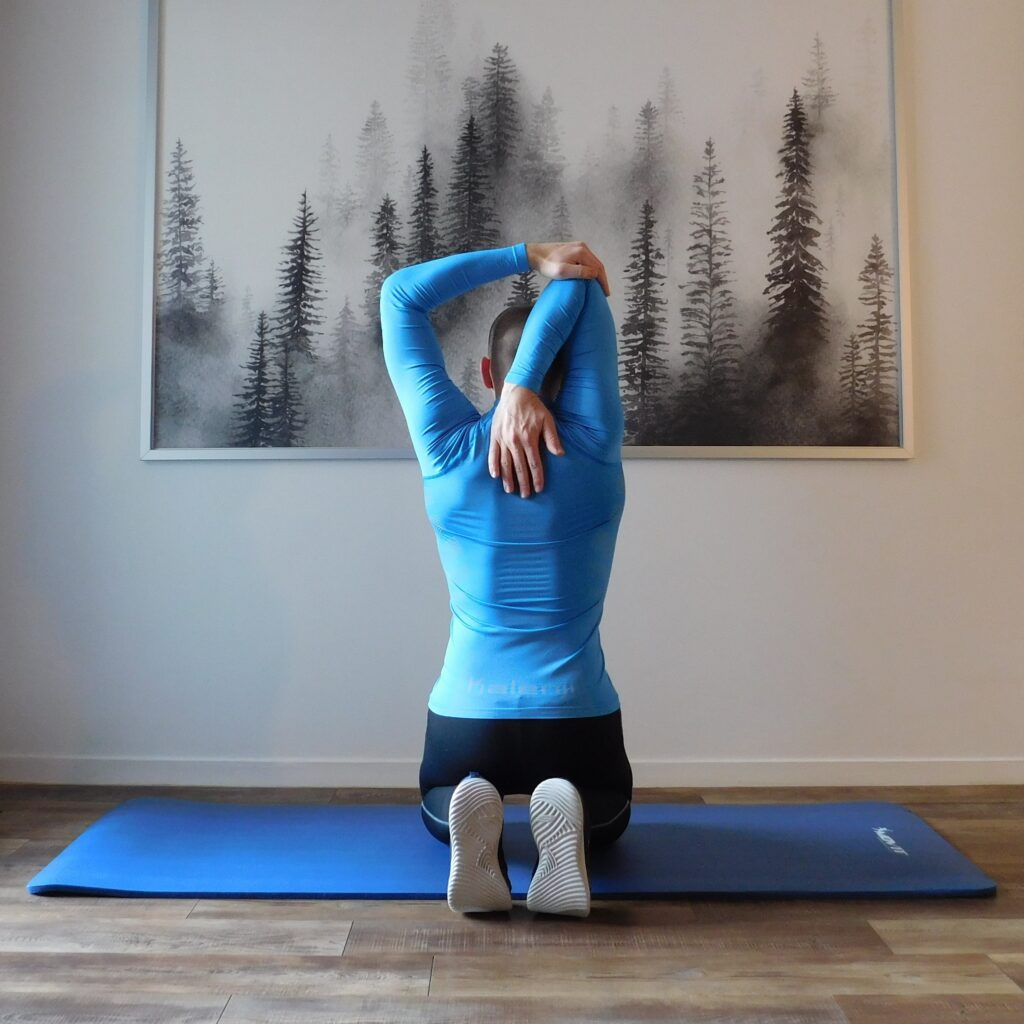
- Kneel, sit, or stand with your feet hip-width apart and your arms extended overhead.
- Bend your right elbow and reach your right hand to touch the upper middle of your back.
- Reach your left hand above your head and grasp your right elbow.
- Gently pull your right elbow down and toward your head, and hold for 30 seconds
- Switch arms and repeat the exercise, then alternate a second time.
Stretching triceps, shoulders and back.
5
Hip stretch
This posture specifically stretches the piriformis and iliopsoas muscles (mainly the rotator and hip flexor muscles) as well as the iliotibial band. Thanks to this and the passive nature of the posture, it is an excellent and gentle approach to help relieve symptoms associated with sciatica and knee pain.
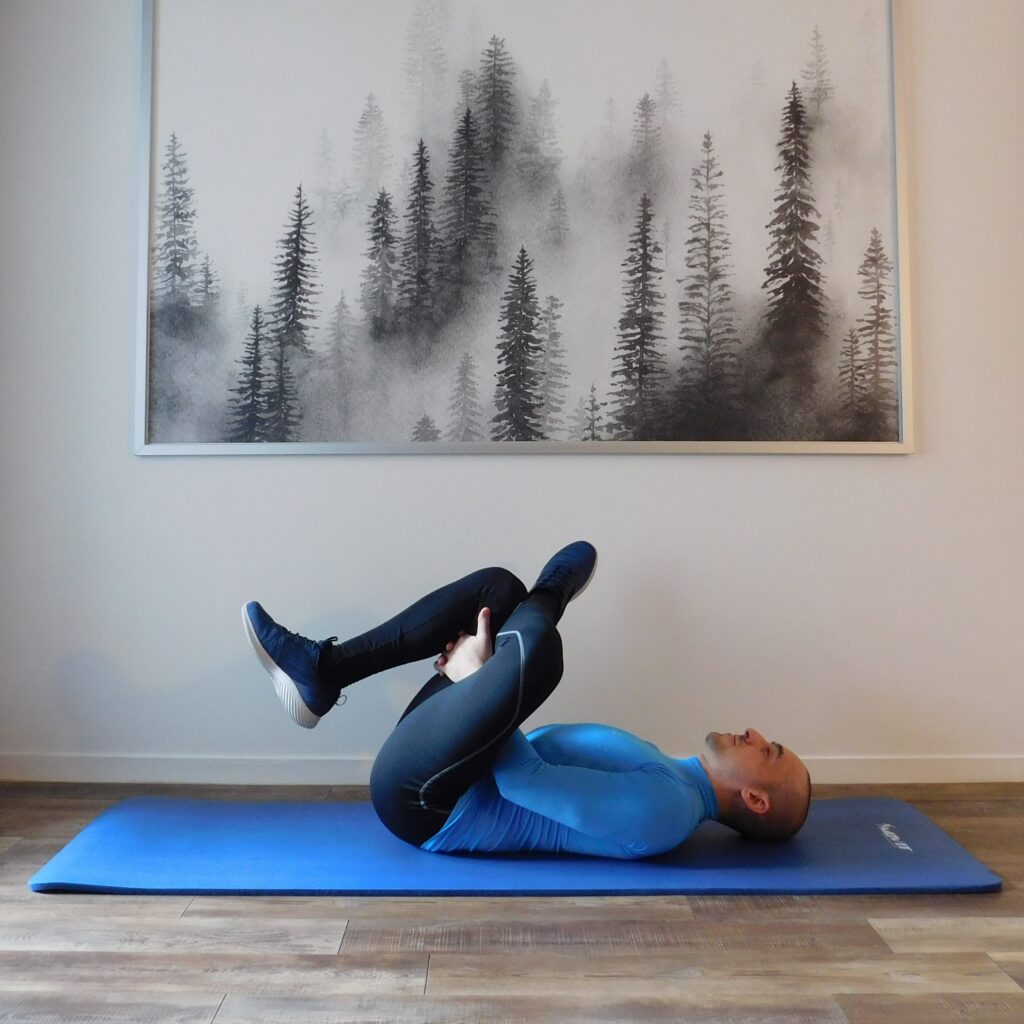
- Lie on your back with your feet flat on the floor.
- Cross your left foot over your right knee.
- Lift your right leg off the floor. Grab the back of your right thigh (or the front of your leg if you are flexible) and gently pull it toward your chest.
- When you feel a comfortable stretch, hold this position.
- Hold this position for 30 seconds.
- Switch sides and repeat, then alternate a second time.
Hip, glute, lower back and hamstring stretches.
6
Hip Stretch: Pigeon Pose
The so-called pigeon posture allows you to internally rotate the leg and thus stretch the hip.
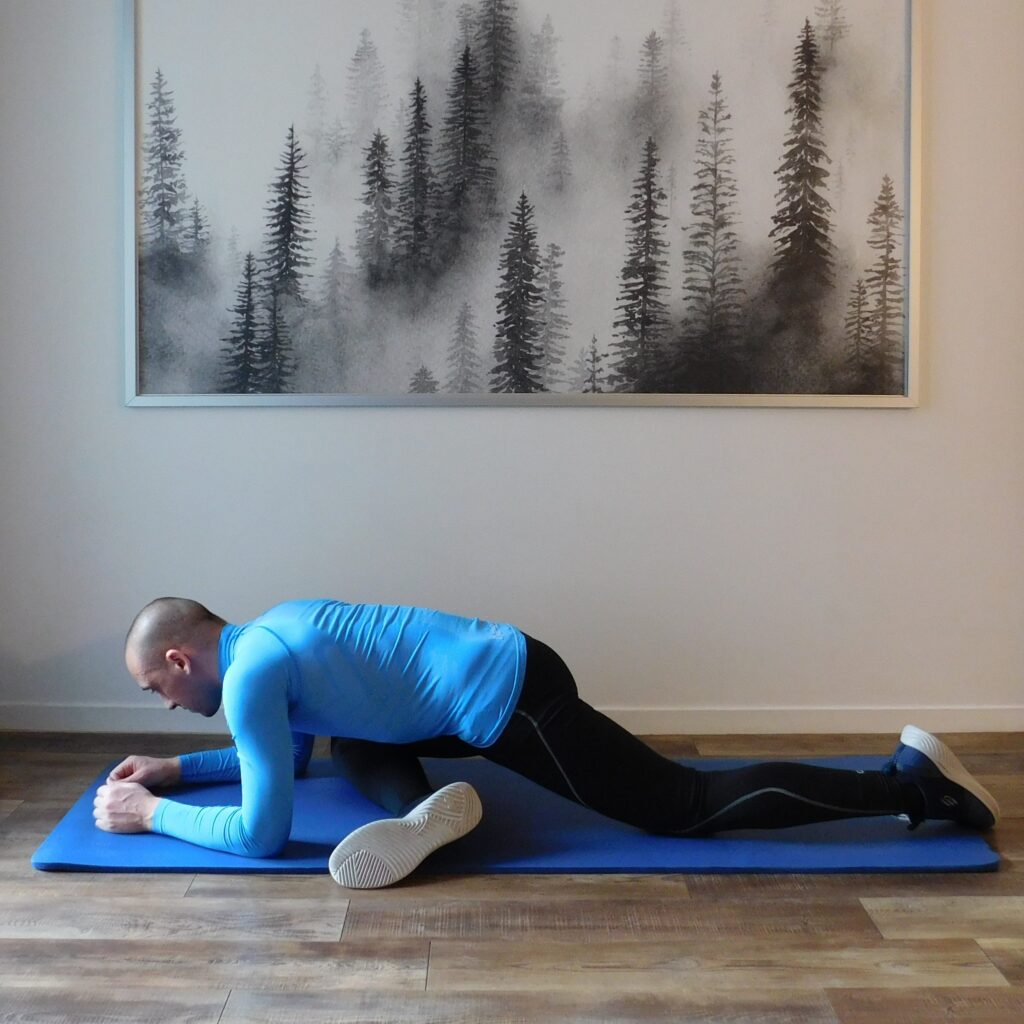
- Start on all fours. Slide the right knee forward and bring the right shin under the bust, the right foot in front of the left knee, the outside of the right shin resting on the ground.
- Gently slide your left leg back, straightening your knee and placing your thigh on the floor. Lower the outside of your right buttock toward the floor. Place the right heel just in front of the left hip.
- Lengthen your lower back by directing the tailbone down and forward. Roll the tip of the left hip toward the right heel and lengthen the left groin.
- Place your forearms and bring your torso towards the ground, above your right leg, while keeping your spine long.
- Hold this position for 30 seconds.
- Repeat the exercise on the other side then alternate a second time.
Hip stretches.
7
Frog Stretch
Most of us sit and cross our legs, which can lead to tight hips and cause lower back pain. This stretch directly targets tightness points in the hips (groin area) and is particularly useful for runners.
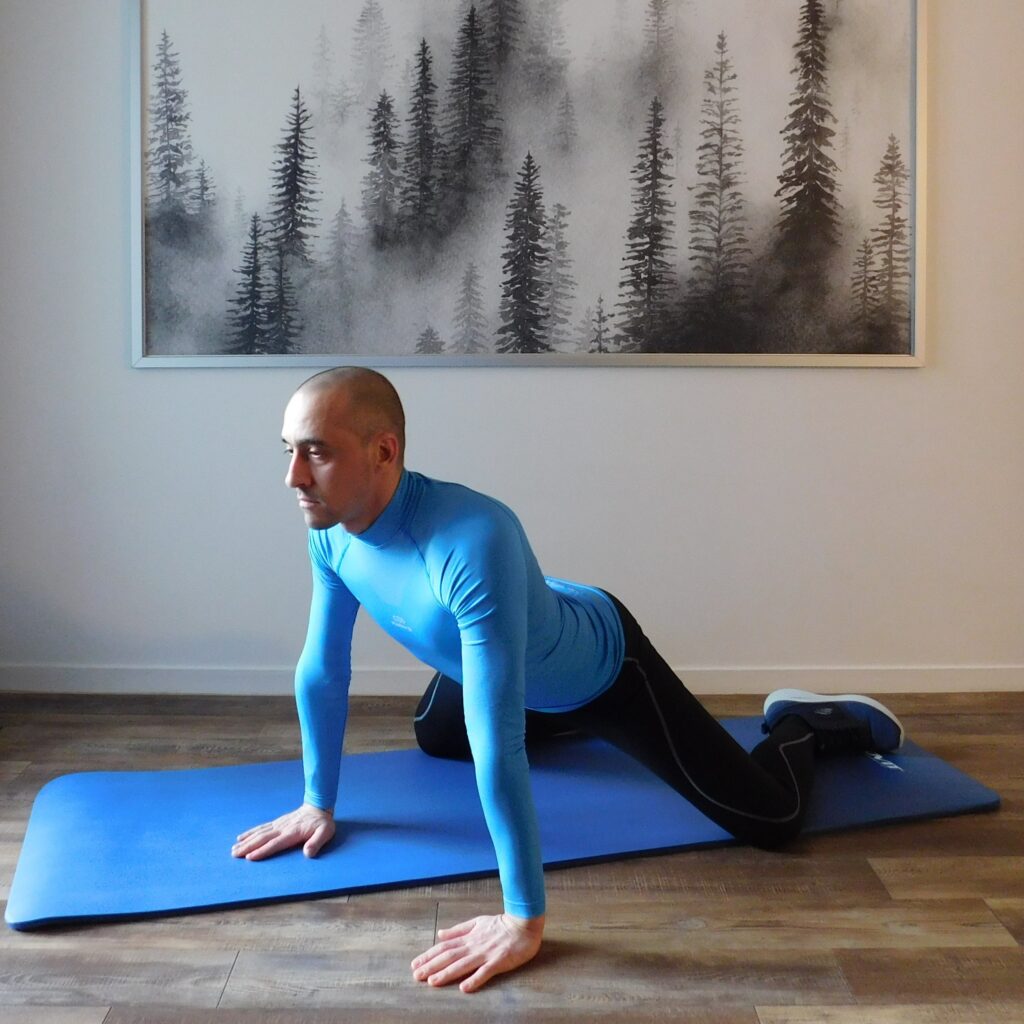
- Start on all fours.
- Slide your knees wider than shoulder-width apart.
- Turn your toes outward and place the inside edges of your feet flat on the floor.
- Move your hips back, toward your heels.
- Switch from your hands to your forearms to get a deeper stretch, if possible.
- Hold this position for 30 seconds to 2 minutes.
Hip and inner thigh stretches.
8
Butterfly stretch
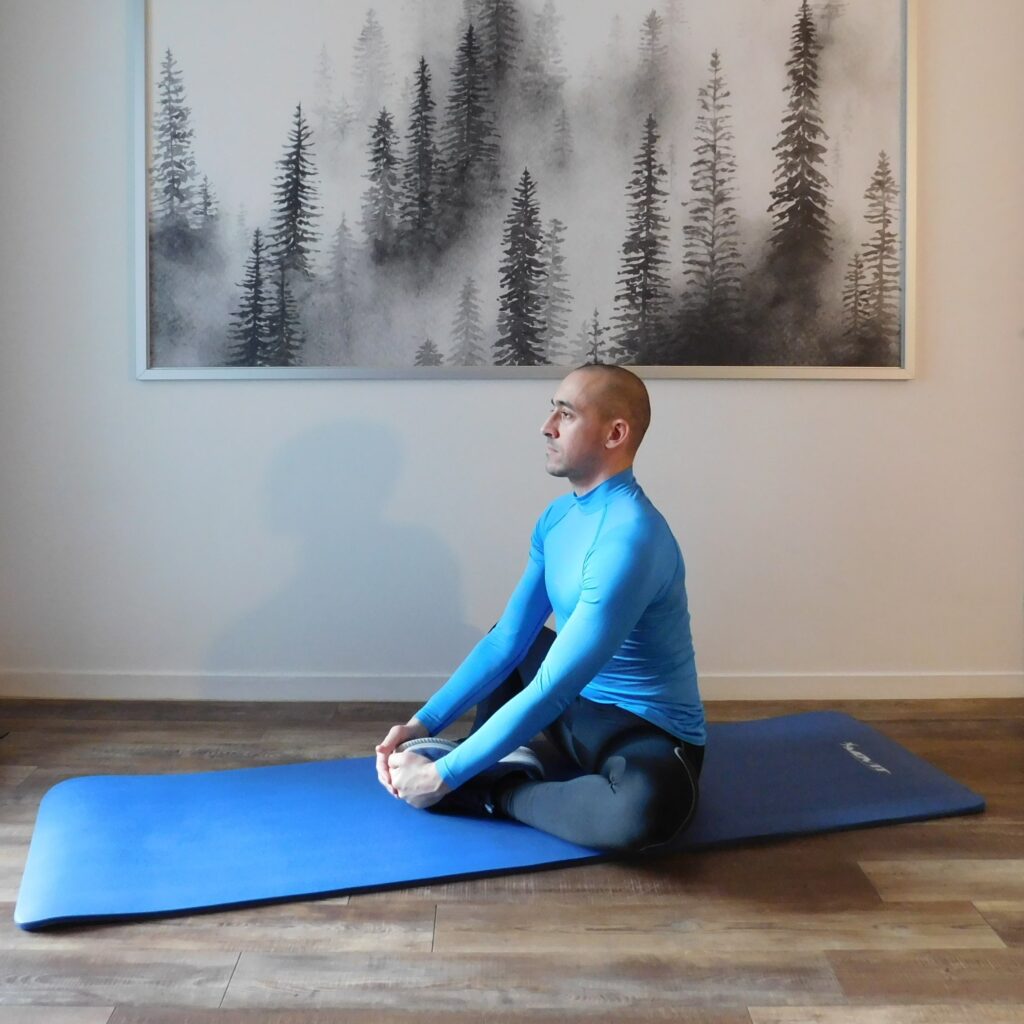
- Sit upright on the floor with the soles of your feet together and your knees bent to the sides.
- Grab your ankles or feet, engage your abs, and slowly lower your body toward your feet as far as possible while pressing your knees toward the floor.
- If you're too tense to bend over, simply press your knees down.
- Hold this stretch for 30 seconds to 2 minutes.
Hip, glute, back and thigh stretches.
9
Seated Shoulder Stretch
Very good stretch that relieves bad posture and releases tension in the upper back.
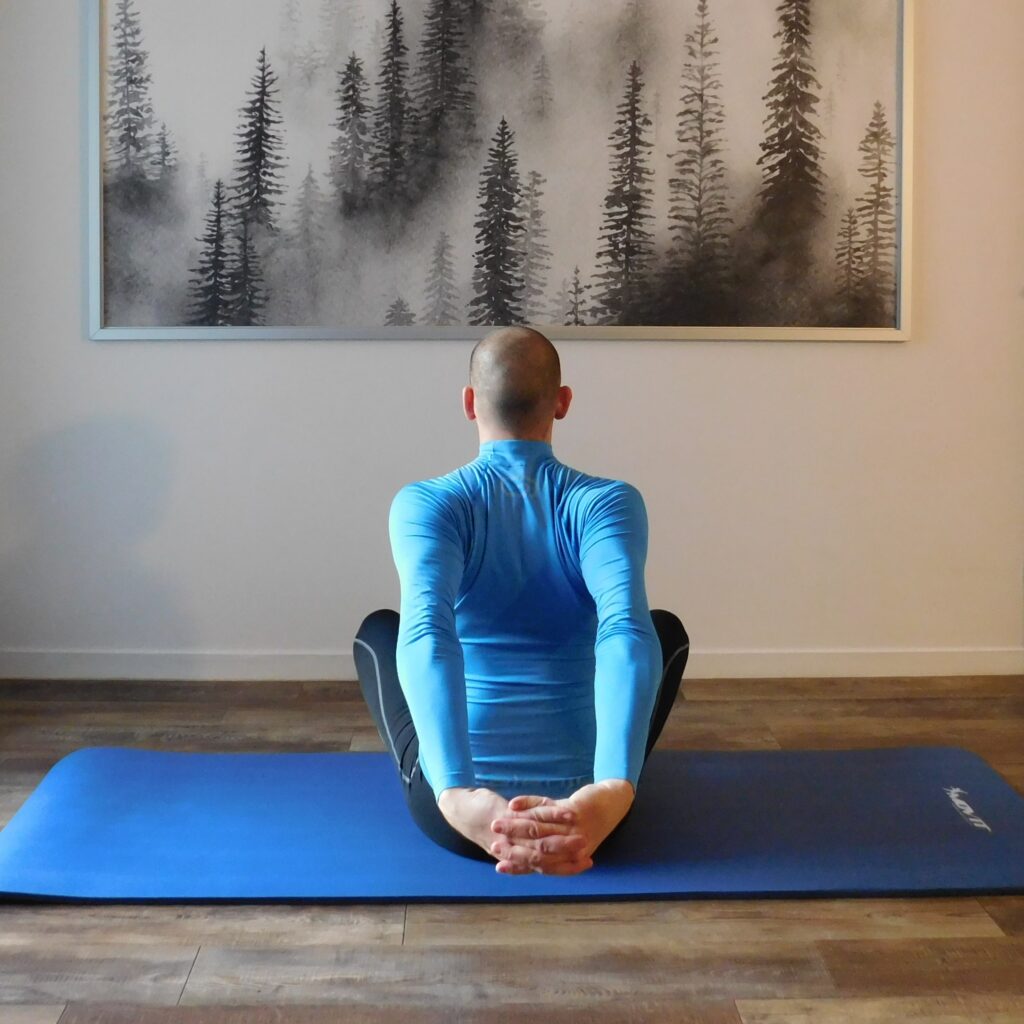
- Sit on the floor with your knees bent, and your feet flat on the floor if you can do it.
- Clasp your hands behind your lower back.
- Straighten and extend your arms and squeeze your shoulder blades together.
- Do this for 3 seconds, then release. Repeat the exercise 5 to 10 times.
Chest, shoulder and upper back stretches.
10
Lateral Bend Stretch

- Kneel on the floor with your legs together, your back straight and your core braced.
- Extend your right leg out to the side. Keep it in the plane of your bust (neither in front nor behind you).
- Stretch your left arm above your head, place your right arm on your right leg and gently lean your torso and left arm to the right.
- Keep your hips facing forward.
- Hold this stretch for 30 seconds.
- Repeat the exercise on the other side then alternate a second time.
Groin, hip, inner thigh and oblique stretches.
11
Lunge Hip Flexor Stretch
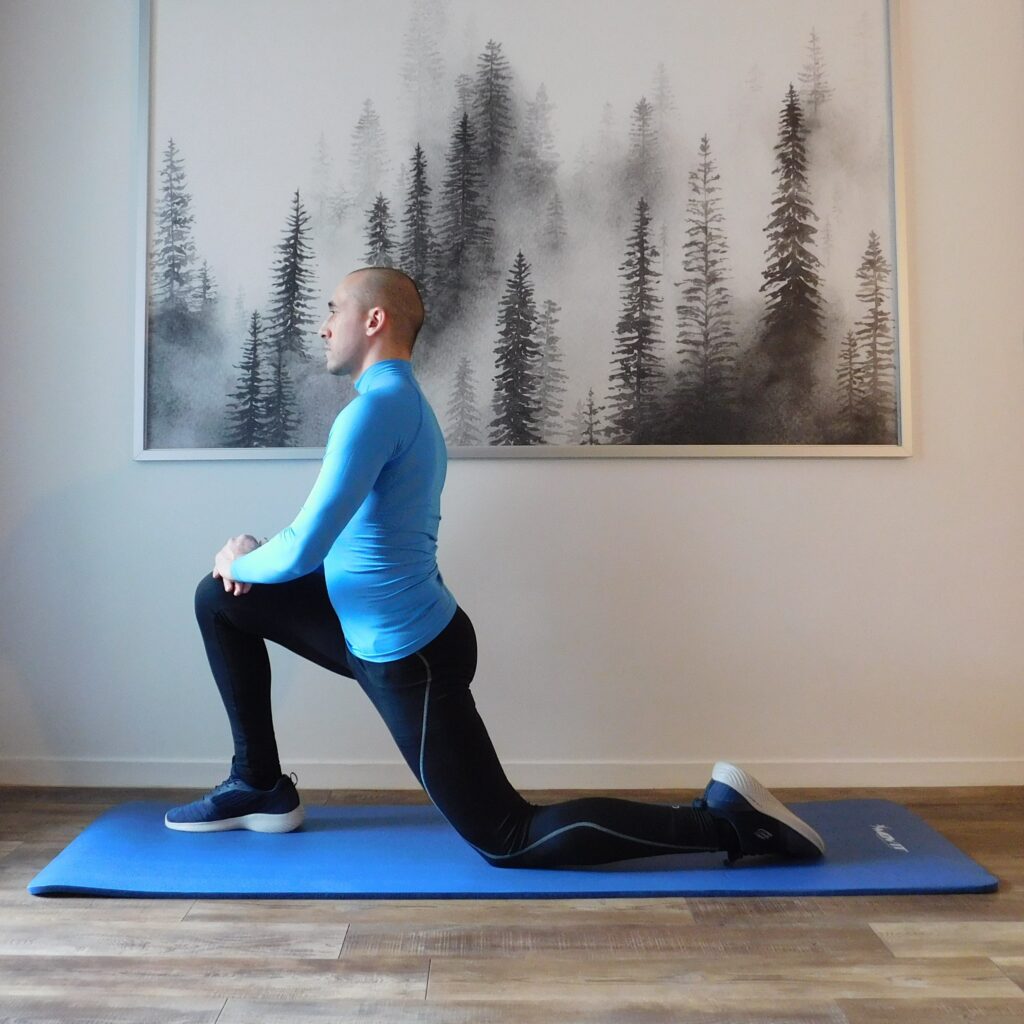
- Kneel on your left knee. Place your right foot flat on the floor in front of you, knee bent.
- Lean forward, stretching your left hip toward the floor.
- Tighten your glutes, this will allow you to stretch your hip flexor even more.
- Hold this position for 30 seconds.
- Switch sides and repeat, then alternate a second time.
Hip, quad and glute stretches.
12
Lying pectoral stretch
This is a great stretch to do before or after pushing movements like push-ups or bench presses.
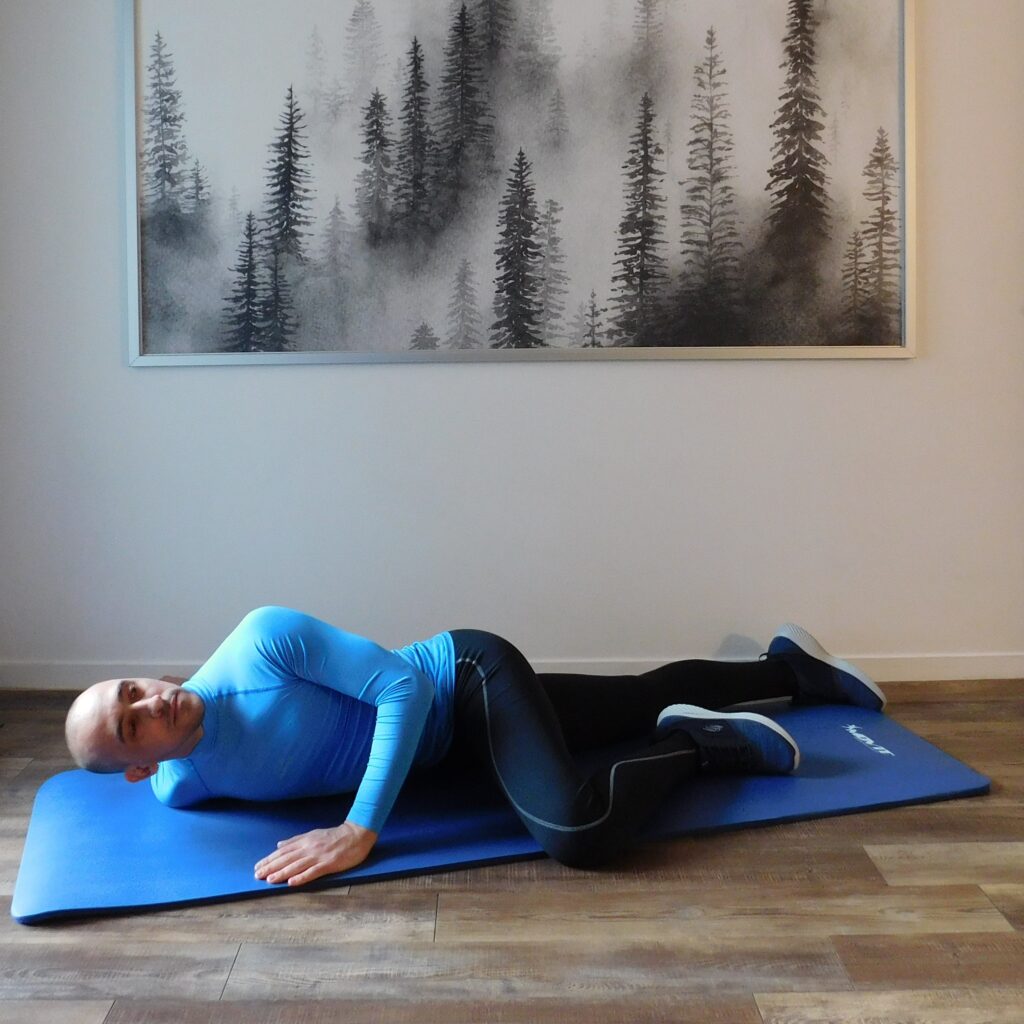
- Lie on your stomach with both arms stretched out to your sides so that your body forms a T shape.
- Push off the ground with your left hand and bend your left knee for balance as you begin rolling onto your right side. You should feel this movement in the pectoral muscles on your right side.
- As your mobility increases, you will be able to stretch more and roll your body further.
- Hold this position for 30 seconds.
- Repeat the exercise on the other side, then alternate a second time.
Chest and shoulder stretches.
13
Knee to Chest Stretch
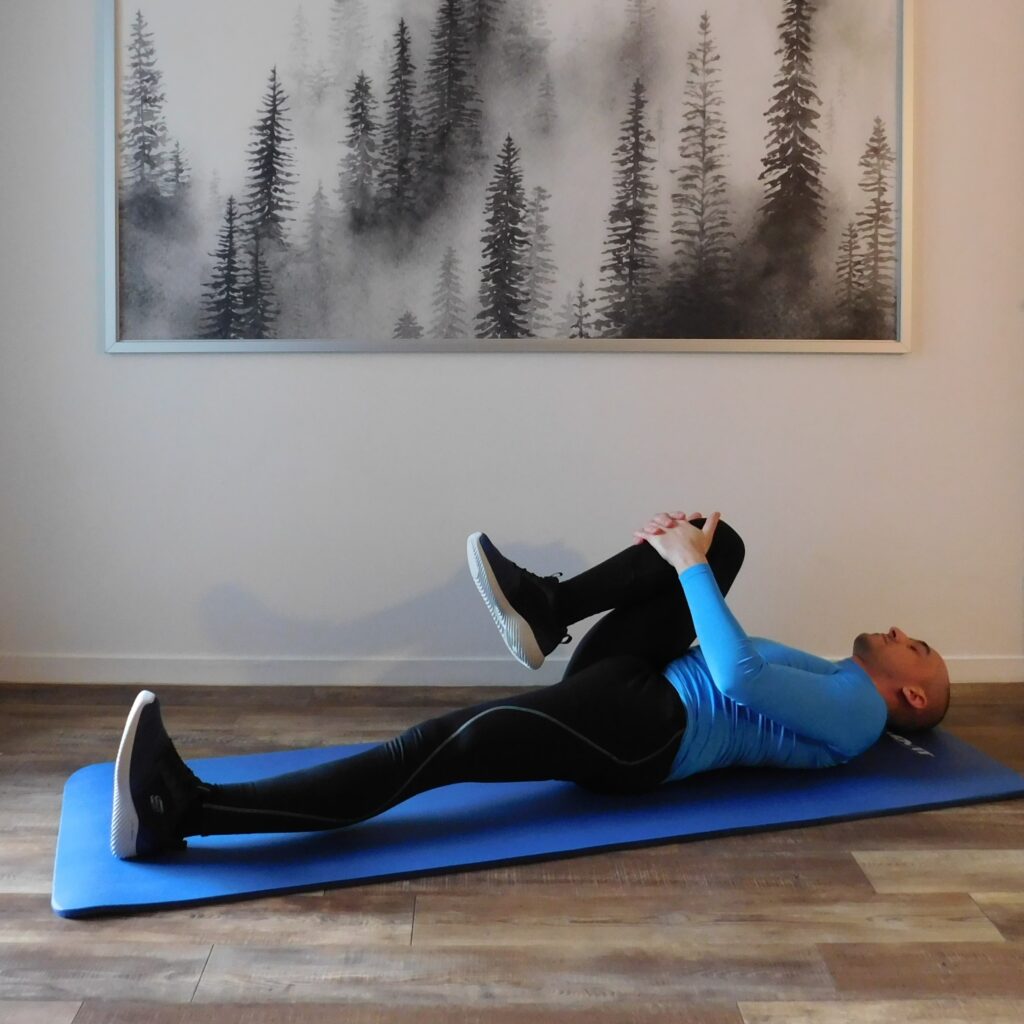
- Lie on your back with both legs straight.
- Pull your right knee toward your chest, while keeping your left leg straight and your lower back pressed into the floor.
- Hold this position for 30 seconds.
- Repeat the exercise with the other leg, then alternate a second time.
Lower back, hip and hamstring stretches.
14
Seated Neck Stretch
Most people tend to forget to stretch their neck. However, relieving tension in the neck can have a positive impact on the rest of the upper body, from the shoulders to the spine.
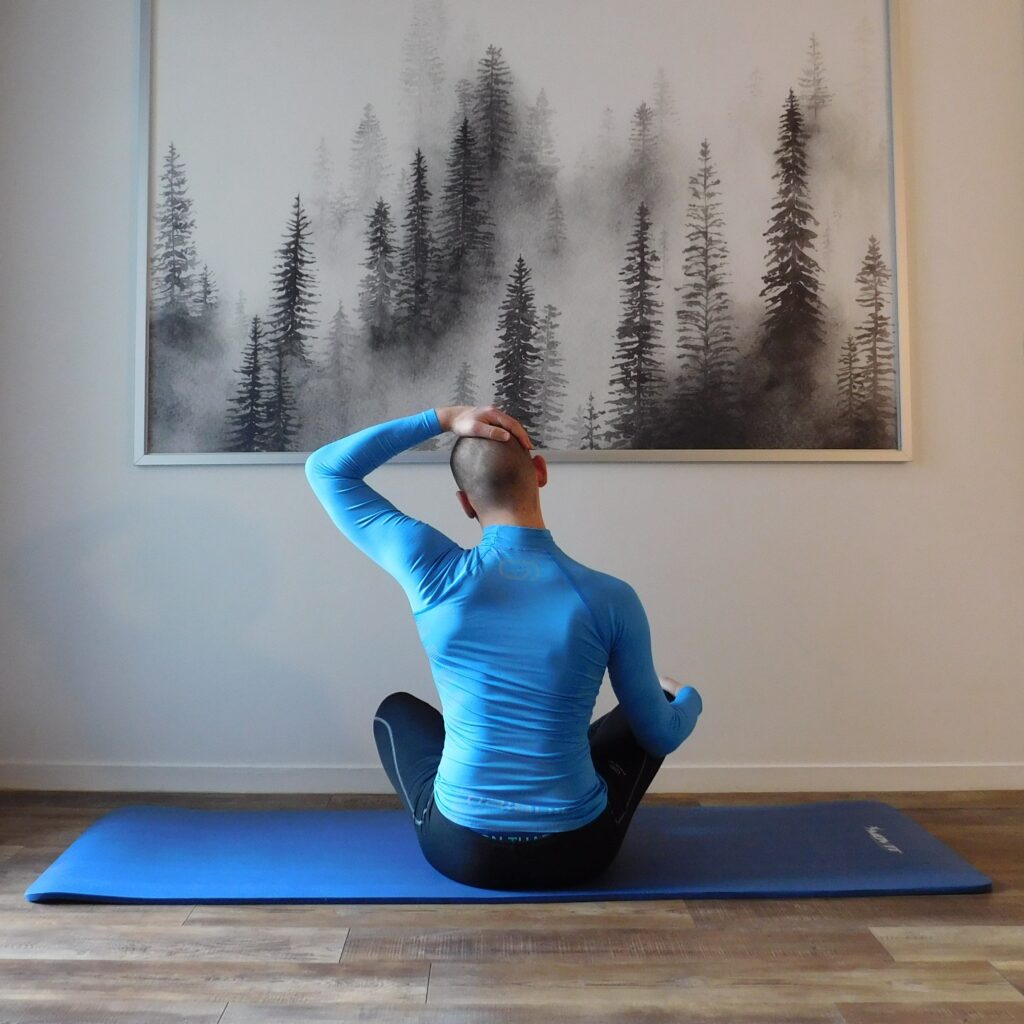
- Stand with your feet shoulder-width apart, or sit with your back straight and your chest lifted.
- Bring your left ear closer to your left shoulder.
- To deepen the stretch, gently press down on your head with your left hand.
- Hold this position for 30 seconds.
- Repeat the exercise on the other side, then alternate a second time.
Neck stretches.
15
Lying Quadriceps Stretch
The quadriceps stretch is one of the most popular lower body stretches, especially if you've just done an endurance (cardio) workout like running or cycling. The lying version, as opposed to the typical standing variation, does not require good balance.
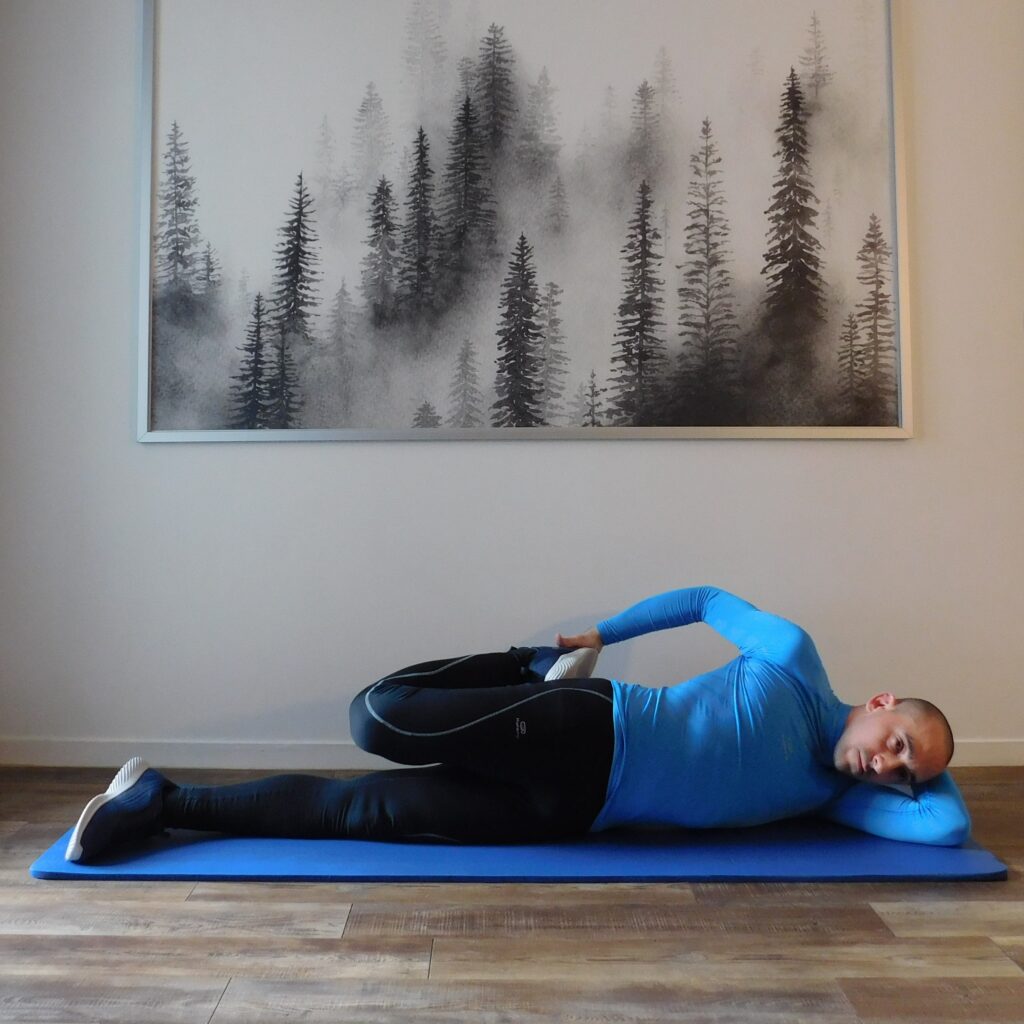
- Lie on one side.
- Keep your lower leg straight and bend your top knee so that your foot is close to your butt.
- Hold your top foot with your hand, pulling it toward your butt.
- Keep your hips steady so you don't tip back as you pull.
- Hold this position for 30 seconds.
- Switch sides and repeat, then alternate a second time.
Quadriceps stretches.
16
Sphinx pose
This posture allows you to gently stretch your lower back. In addition, it works the abdominals, which strengthens the lower back.
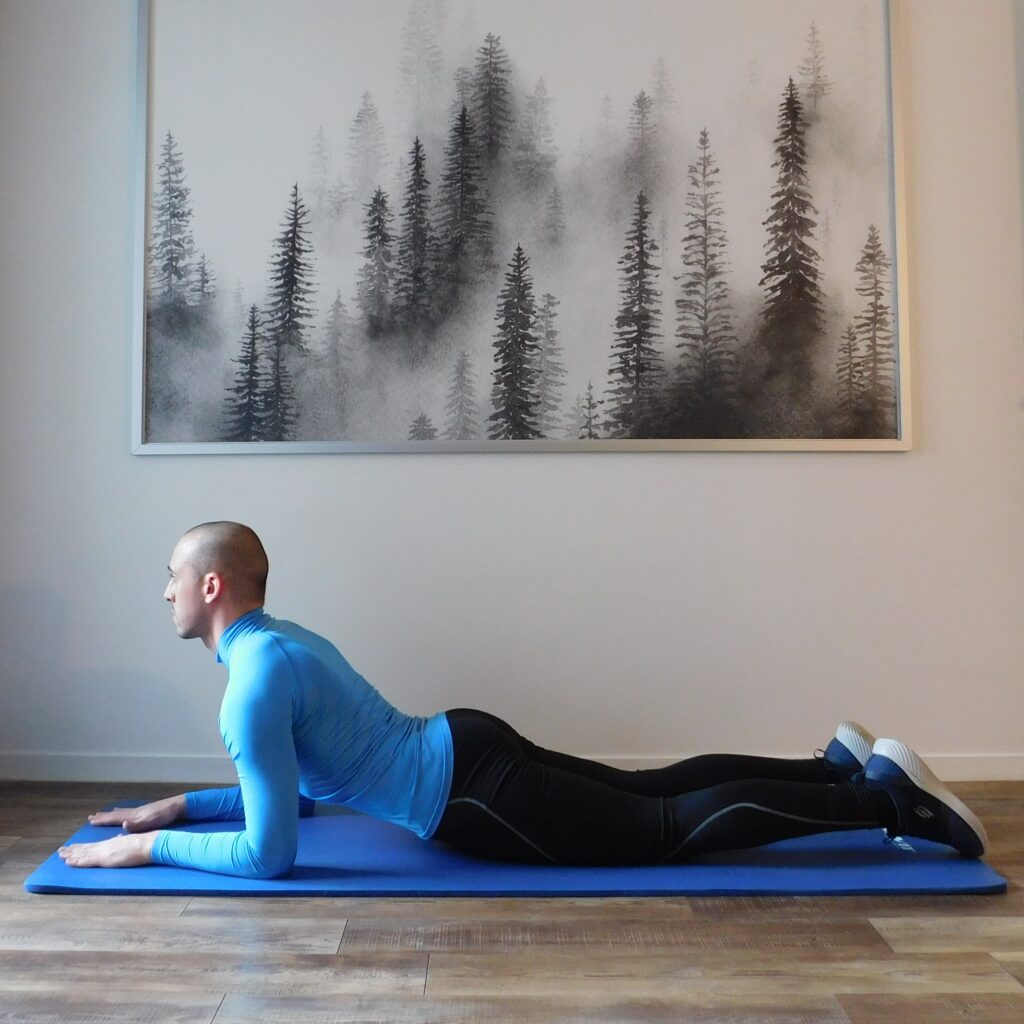
- Lie on your stomach with your legs stretched behind you.
- Place your elbows under your shoulders and your forearms on the floor as you lift your chest off the floor.
- Press your hips and thighs into the floor, and think about lengthening your spine while keeping your shoulders relaxed.
- Stand up just enough to feel a good stretch in your lower back. Do not hyperextend and stop immediately if you begin to feel discomfort or pain.
- Hold this position for 30 seconds to 2 minutes.
Lower back, chest and shoulder stretches.
17
Lying puppy pose
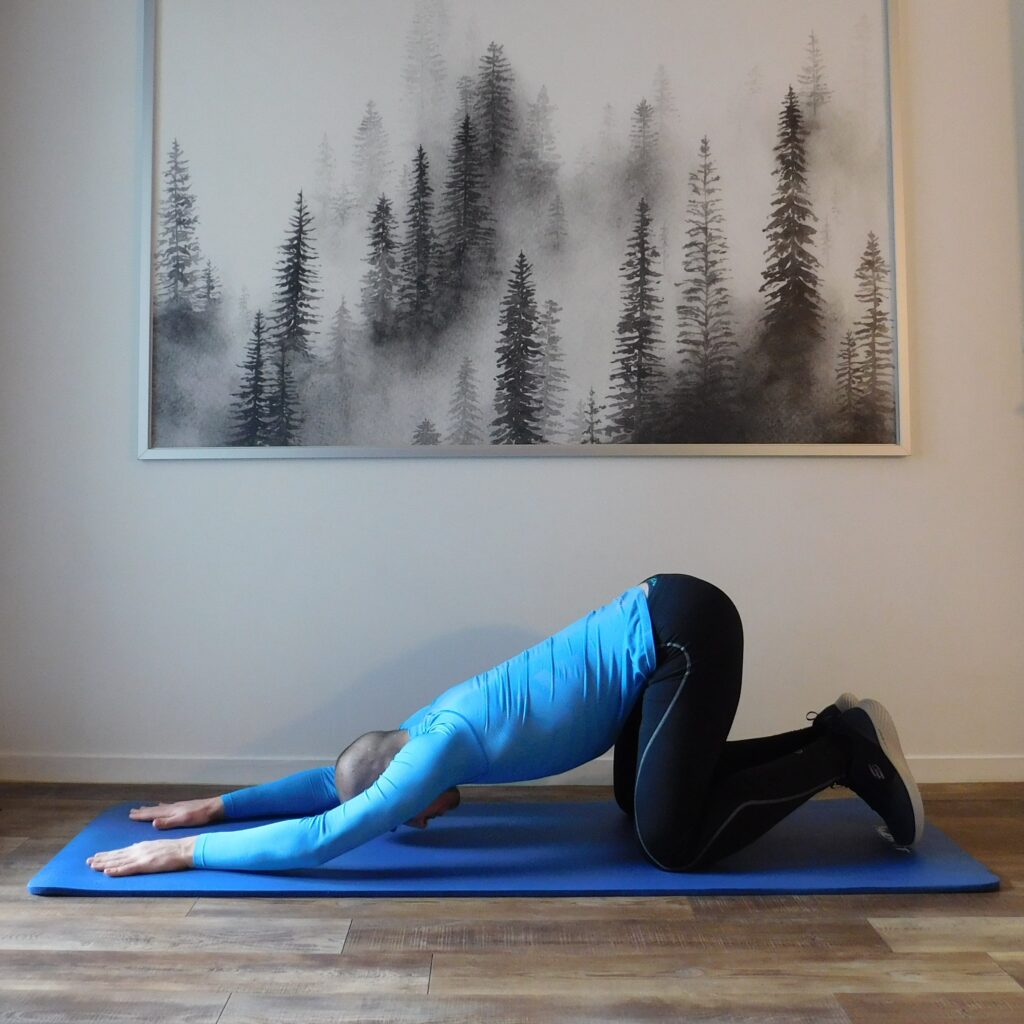
- Get on all fours.
- Move your arms forward a few inches and curl your toes downward.
- Push your hips up and step back halfway through your heels.
- Push with the palms of your hands to keep your arms straight and engaged.
- Hold this position for 30 seconds to 2 minutes.
Back, shoulder and glute stretches.
18
Pretzel pose
The pretzel stretch stretches several important postural muscles in a single movement, which can be a huge time saver. You'll stretch the quads of your lower leg, your spine, and the glutes and hip flexors of your upper leg.
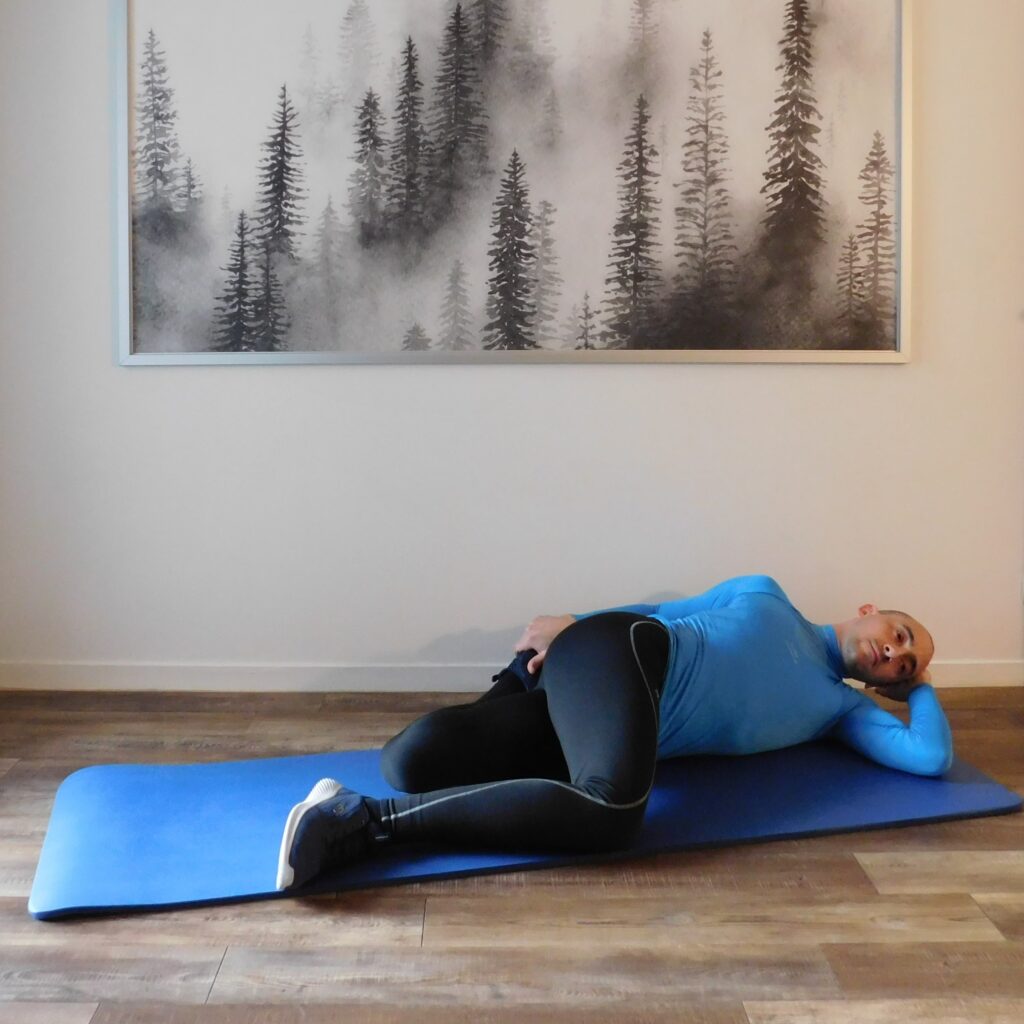
- Lie on your left side with your head resting on your arm.
- Bend your right knee and hip toward your chest as far as possible, then let them drop to the floor.
- Bend your left knee and grab your left foot (use a strap if you can't reach it) with your right hand.
- Make sure your leg and torso stay in a straight line as you gently bring the top of your straight shoulder blade toward the floor.
- For a greater spinal twist, turn your head to look over your right shoulder.
- Hold this position for 30 seconds.
- Switch sides and repeat, then alternate a second time.
Quadriceps, glutes, obliques, hips and back stretches.
19
Adductor stretch
This is a great stretch to do both as a gentle warm-up and at the end of a workout as a release pose. Due to the passive nature of the posture, it can and should be adjusted based on how you feel about your body to encourage proper stretching and release.
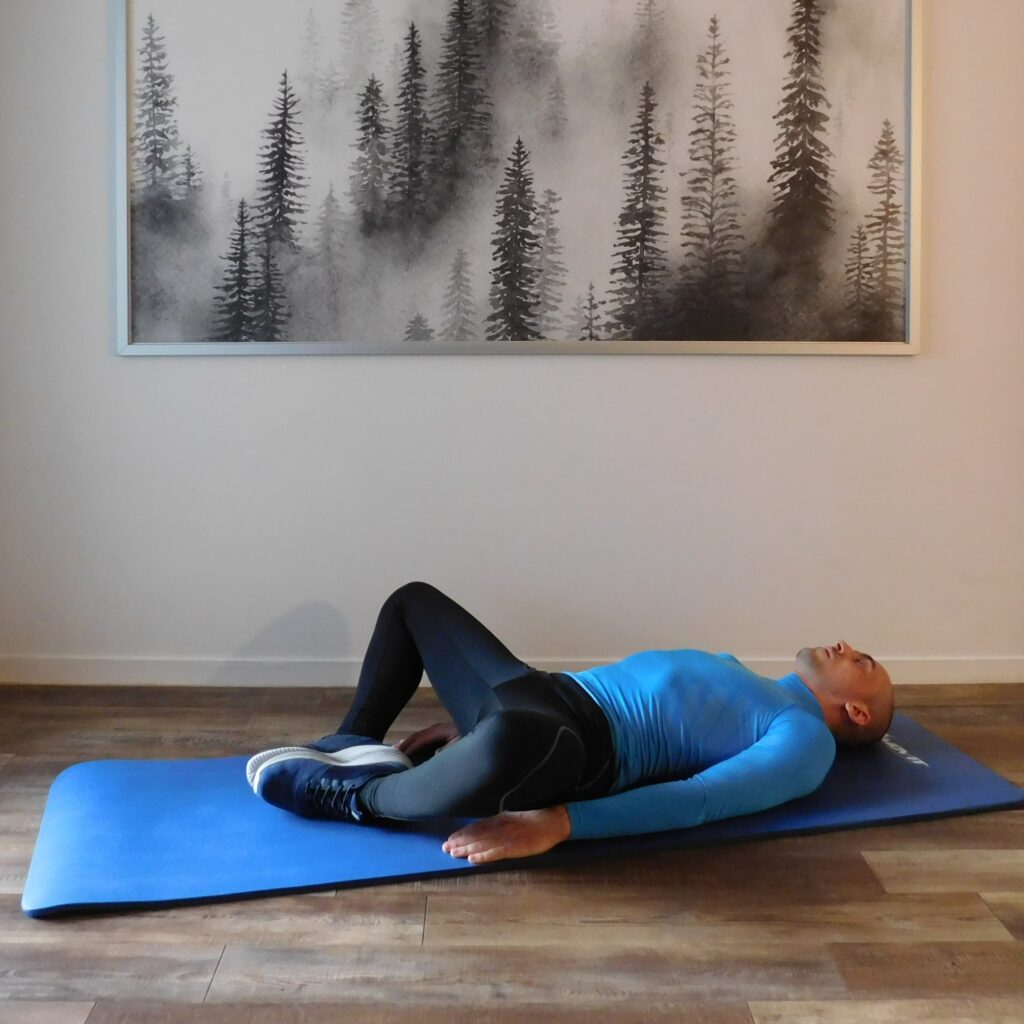
- Lie on your back.
- Bring the soles of your feet together and allow your knees to open and come closer to the floor.
- Hold this position for 30 seconds to 2 minutes.
Stretches of the inner thighs, hips and groin.
20
Standing Quadriceps Stretch
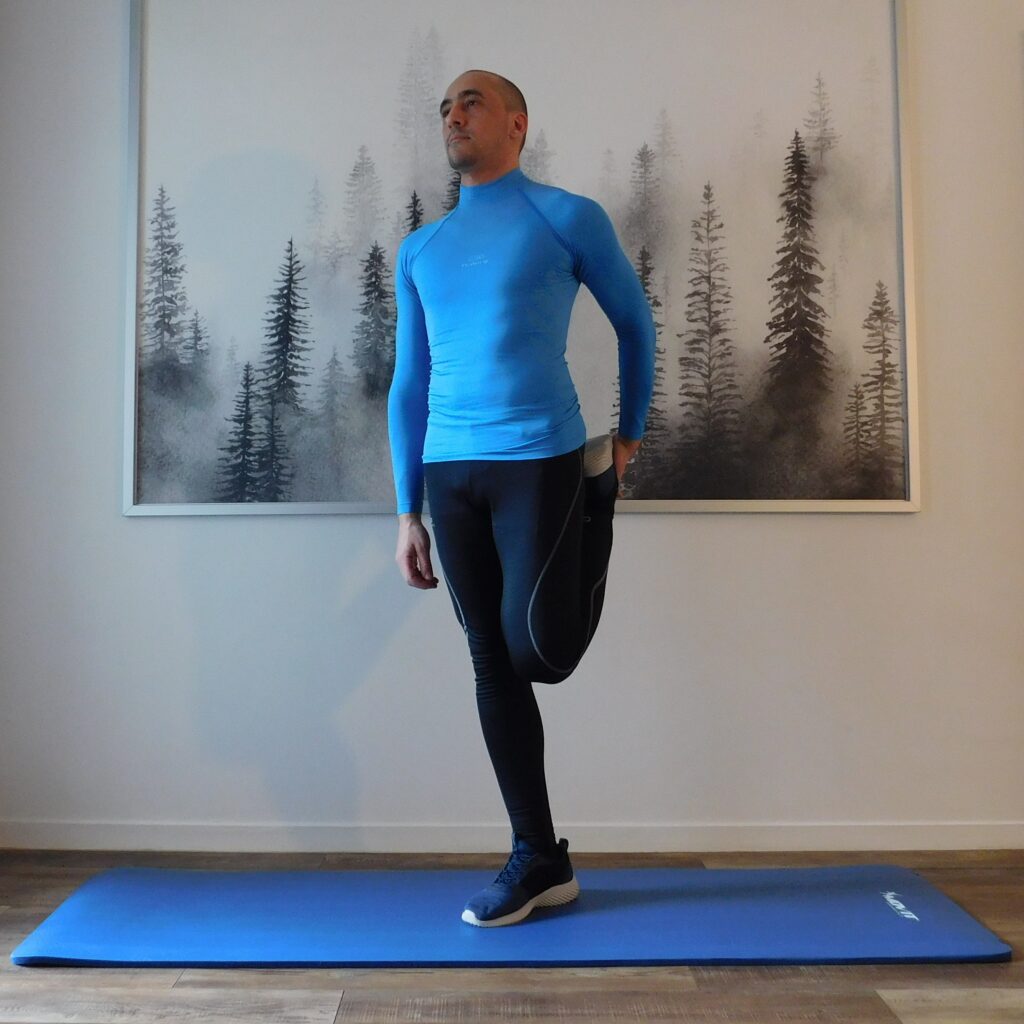
- Stand with your feet together.
- Bend your left knee and use your left hand to pull your left foot toward your butt. Keep your knees together.
- If you need to, place your right hand on a wall for balance.
- Contract your glutes to increase the stretch in the front of your legs.
- Hold this position for 30 seconds.
- Repeat the exercise on the other leg, then alternate a second time.
Quadriceps stretches.
21
Knees to chest
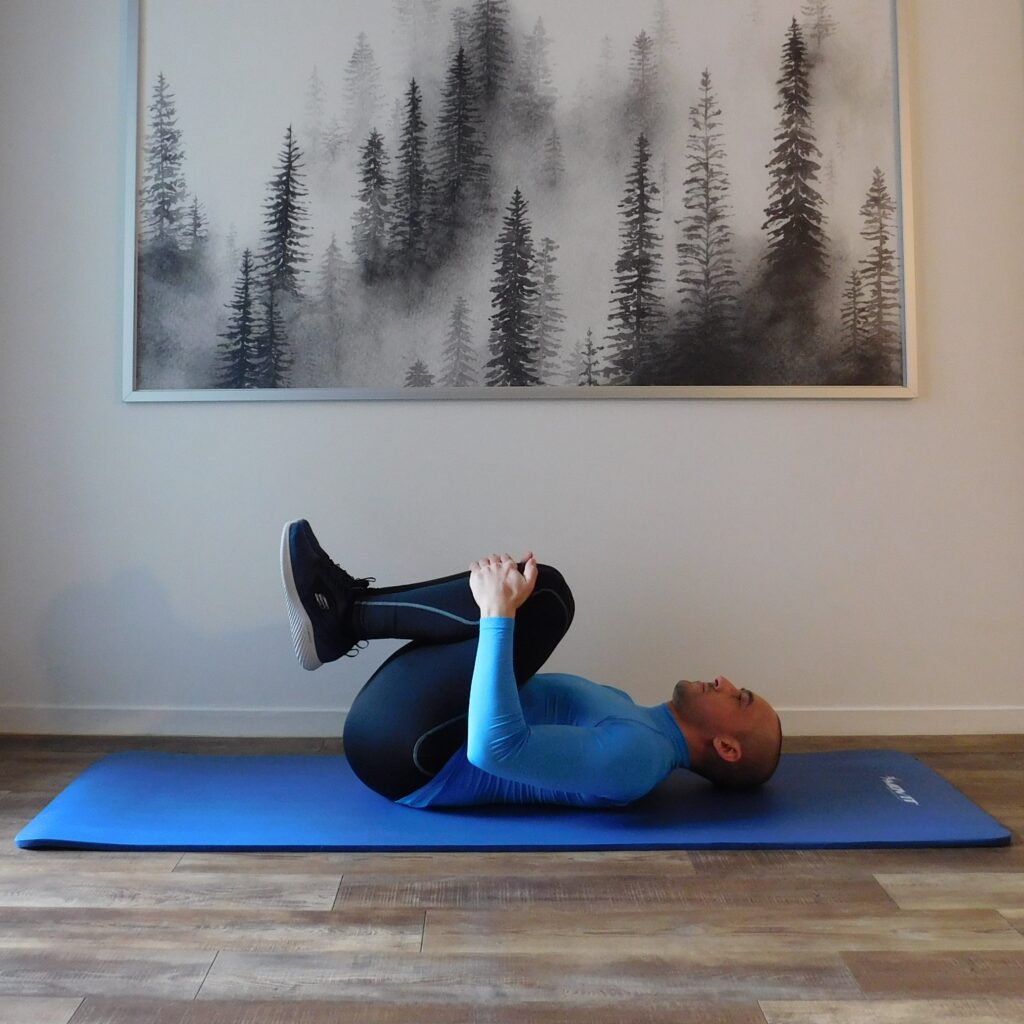
- Lie on your back and pull your knees toward your chest with both hands.
- Keep your lower back glued to the floor.
- Hold this position for 30 seconds to 2 minutes.
Lower back and glute stretches.
These stretches will help you to be more flexible and potentially reduce the intensity of your pain or even get rid of it. If your pain is chronic and you feel that additional help is needed, I invite you to make an appointment with me for one chinese massage.
Take care of yourself 🙏🏼
Share this article with your loved ones and friends 🙂

